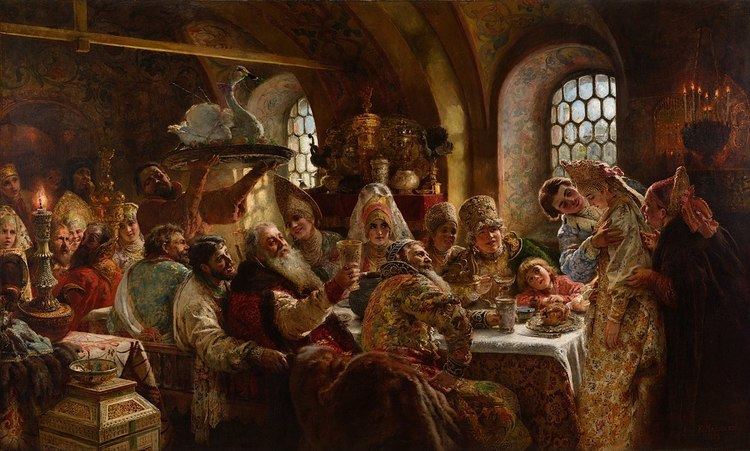 | ||
A traditional Russian wedding lasts for at least two days and some weddings last as long as a week. Throughout the celebration there is dancing, singing, long toasts, and a lot of food and drinks. The best man and maid of honor are called witnesses, svideteli in Russian. The ceremony and the ring exchange takes place on the first day of the wedding. Russian weddings have adopted some of western traditions, including bridesmaids and others.
Contents
Traditional wedding rituals
A friend of the bride who is already married places the first earring on the bride-to-be.
Paying the ransom
Once the groom arrives at the bride’s home, he must pay a ransom for the bride, a term in Russian known as vykup nevesty. The entire event is played out in a comical fashion and everyone is entertained. At first the groom comes and gives something (often money or jewelry) for the bride, and so the parents of the bride bring out a woman or man (the latter for amusement) that is not the actual bride, but is dressed up like one, covered in a veil, so the groom can't see their face. When the groom realizes that it is not his bride, he asks for his love, but the family of the bride will demand a bigger ransom to be paid. So, upon satisfaction with the ransom given, the bride's family gives away the bride to the groom.
Traditional ceremony
In the next step, the bride and groom have an optional traditional ceremony in a church. In Russian this is called the venchanie. The wedding ceremony takes place in a church and is divided into two parts: the Betrothal and the Crowning. The service traditionally takes place in the morning, after the celebration of the Divine Liturgy, during which the wedding rings were blessed by being placed on the Holy Table (altar).
Betrothal
While the betrothal used to be blessed at the beginning of the engagement, it is now commonly done at the same ceremony as the wedding itself.
The bride and groom stand inside the entrance of the church and the priest blesses them and gives them lighted candles which they will hold throughout the ceremony. The deacon leads an ektenia (litany) with special petitions for the couple. The priest then says two brief prayers for the couple and the rings are blessed and placed on the couple's right hand.
The priest then says a prayer blessing the couple's betrothal which mentions instances in the Bible where rings are used and relates those instances to the betrothal.
Crowning
In the Eastern Orthodox Church Holy Matrimony is considered a Sacred Mystery (sacrament), and the sign of the marriage is not the exchange of rings (that takes place at the betrothal) but rather the placing of crowns on the heads of the bride and groom. For this reason the ceremony of the wedding is referred to as the Crowning.
The priest leads the couple into the center of the church where they come to stand on a piece of new, rose colored fabric, symbolizing their entry into a new life. The bride and groom each publicly professes that they are marrying of their own free will and that they have not promised themselves to another.
Then after an ektenia and several longer prayers the priest places crowns on the heads of the bride and the groom. These are usually held over their heads by members of the wedding party. Then follow readings from the Epistle and Gospel, ektenias, brief prayers and the sharing of a "common cup" of wine by the bride and groom.
Then a procession takes place during which the priest wraps his epitrachelion (stole) around the joined hands of the bride and groom and leads them (followed by their attendants who are holding the crowns) three times around an analogion on which the Gospel Book has been placed. This procession symbolizes the pilgrimage of their wedded life together.
It used to be the custom that the bride and groom would wear their wedding crowns for eight days, but now the removal of the crowns is customarily done at the end of the service. The priest says benedictions for the bride and groom and then the dismissal takes place.
Civil ceremony
Following the traditional ceremony, the couple must have a civil ceremony called rospis v zagse. This ceremony takes place at the department of public services, formally known as ZAGS. At ZAGS the couple is greeted by family members with bread and salt. The ceremony ranges from 15 to 30 minutes and during this time the rings are exchanged and the couple is pronounced husband and wife.
During the civil ceremony, the parents offer the married couple two crystal glasses, which they are asked to break. The more shards of glass they create, the greater the number of years of happiness they will spend together.
It is also customary for the married couple to release either balloons or, better, two white doves to symbolize their love and partnership which is written in the sky for all to see. And the bride also releases another balloon with her maiden name written on it, as she embarks on her new life.
Tour of the city
Following the civil ceremony, the newlyweds and their witnesses, travel around the city in a limousine and view many historical sites. Sometimes very close friends join as well. This presents the primary opportunity for the majority of the wedding photographs that are taken at varying historical places around the town or city.
Reception
After touring the city for several hours, the couple meets the guests for the reception.
